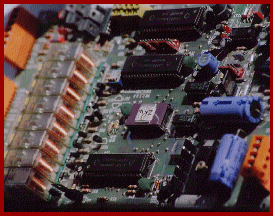| |||||||||||||||||||||||||||
Welcome to the | |||||||||||||||||||||||||||
 | |||||||||||||||||||||||||||
 | |||||||||||||||||||||||||||
Since the mid 70’s and some would say as a direct result of the ‘space race’, "Digital" Telemetry control has grown in popularity to achieve number 1 status as the prefered control system of choice. Although technically complex in construction, the actual operation of a telemetry system is extremely simple to understand. Within the ‘Transmitter’ there is a small (computer) microprocessor board, which generates a code signal at the press of a button. This signal is then sent directly to the receiver card, which again is fitted with mirror de-coding circuitry, that interprets the command and then switches an electrical relay, to send the correct driving voltage to the appropriate piece of equipment. Notwithstanding the apparent complexity of the internal circuitry, modern Telemetry systems are actually very simple to install, operate and configure into systems .... as large as you like. Off the shelf transmitters (TX) are available for single, eight, sixteen or more camera units, and for larger networks covering hundreds of cameras, telemetry can be directly interfaced with a ‘matrix’ switcher, or touchscreen / PC based package. In operation, there are various options in terms of signal transmission. ‘Down the Co-Ax’ is historically perhaps the most common approach, where the video signal cable carries both the picture and control information, albeit in opposite directions. Although there is no need to provide an additional control cable, under certain circumstances, for example if using ‘line powered’ cameras, this may be necessary. ‘Twisted Pair’ transmission uses a basic grade screened data cable (pair) to relay the control signals to the receiver (RX) unit. One fairly standard and long established technique is known as 20mA (milli amp) current loop, although in recent years, standardised data signal protocols such as RS 232 and RS 485 have become | |||||||||||||||||||||||||||
 | |||||||||||||||||||||||||||
IMPORTANT: No material may be reproduced, copied or redistributed from this site, © doktorjon.co.uk 2004 - 2008 Homepage...:...Gateway...:...Technical Gateway....:....Quickfind Index....:....Equipment Directory | |||||||||||||||||||||||||||

